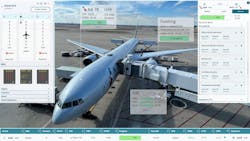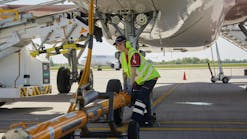Technology and innovation play a crucial role in optimizing aircraft turnaround times.
Innovative solutions enable ground handlers, airport operators and airlines to streamline processes, reduce costs, enhance safety, demonstrate a commitment to creating sustainable aviation and ultimately improve the overall passenger experience.
The impact of technology on optimizing aircraft turnaround times, in a word, is “huge,” says Ilya Burkin, business development director at ADB SAFEGATE.
“Efficient aircraft turnaround solutions are critical to the aviation industry's success. Through innovative solutions powered by advanced technologies such as artificial intelligence (AI), machine learning and predictive analytics, aviation stakeholders can equip themselves with tools to implement automated and seamless processes. Technology can significantly reduce the time taken to prepare an aircraft for its next flight while ensuring that all safety requirements are met,” says Burkin.
One example is ADB SAFEGATE’s Intelligent AiPRON, which Burkin says was created in response to the pressing need within the aviation industry to address operational inefficiencies, optimize resource utilization and ensure on-time departures.
“The significant financial impact of delays, coupled with the complex coordination required among various stakeholders, prompted the development of Intelligent AiPRON as a groundbreaking solution to revolutionize the aircraft turnaround process,” says Burkin.
The Intelligent AiPRON product line from ADB SAFEGATE consists of several distinct add-on software modules that cater to different aspects of apron activities from takeoff to landing.
At the heart of ADB SAFEGATE technology is SAFEDOCK A-VDGS (advanced visual docking guidance system) and AiPRON Manager, which includes the Just-In-Time (JIT) docking feature. The JIT docking feature optimizes docking procedures by minimizing the time aircraft spend on the apron, ensuring optimal docking times that reduce congestion and minimize operational delays.
AiPRON 360 is another key component of ADB SAFEGATE’s technology portfolio, providing ground handlers with a visual representation of the aircraft turnaround process. The module includes features such as air traffic location data, predictive alerts and turnaround status, all visible on a single screen, making the monitoring process more efficient and collaborative. Burkin says the module's communication platform enhances collaboration throughout the turnaround process, leading to better decision-making and improved operational performance.
AI-driven, AiPRON 360 manages aircraft turnaround activities from landing to takeoff. The module enhances collaboration between ground handlers and respective stakeholders by providing a visual representation of the turnaround process, scheduling workflows and tracking real-time progress, among others.
The technology starts working during the aircraft's final approach, when final preparation tasks, such as foreign object debris (FOD) checks, are communicated to stakeholders.
As the aircraft approaches the gate, AiPRON Manager activates the JIT docking feature, which precisely determines the aircraft's position and safely stops it in the exact stop point. This reduces the risk of unnecessary contact between the aircraft and ground support equipment (GSE), ultimately leading to decreased aircraft ground damage incidents and significant cost savings on repairs.
Once the aircraft is safely docked, AiPRON technology provides precise in-block time to the airport operational database (AODB) and other systems, enabling ground handlers to track progress made during the turnaround process in real-time. The AiPRON 360 and AiPRON Connect modules provide real-time updates on the status of each activity, GSE usage and recommendations in case of any irregularities. This leads to better decision-making, efficient resource utilization and seamless communication between all stakeholders, Burkin says.
To predict the off-block time and provide recommendations for improving turnaround activities, AiPRON 360 uses machine learning. Ground handlers can optimize workflows by prioritizing tasks and communicating through mobile applications, ramp information display system (RIDS) and third-party apps.
When the aircraft is preparing for departure, AiPRON Manager will communicate with the pilot through the RIDS screen and activate the Tail Clearance functionality.
“Our solution uses advanced sensors and algorithms to determine potential movements behind the aircraft and avoid any collision or costly accidents, ensuring the aircraft's safety during the departure process,” says Burkin.
“We also offer fully automatic pushback procedures that eliminate the need for wing walkers by integrating with the airfield lighting systems. The integrated system automatically blocks any traffic on taxiways and service roads behind the aircraft. This reduces operational delays, enhances operational efficiency and eliminates the need for additional personnel during the pushback procedure.”
Intelligent AiPRON works on multiple stands and gates, enabling ground handlers to orchestrate the movements and activities of the entire apron seamlessly.
Although each module has its specific functions, they can be deployed independently or integrated into a comprehensive and seamless platform, providing a powerful solution for efficient apron management.
“The technology can be purchased by various industry players and is a customizable and flexible solution that addresses the unique needs of each stakeholder, contributing to the optimization of airport operations and enhancing the value delivered to passengers and airline customers,” says Burkin.
Typically, he says Intelligent AiPRON technology is purchased by airports and airlines. Ground service providers can also purchase the technology or offer it as part of their services to their clients.
“The technology specifically benefits ground handlers by providing real-time visibility into turnaround activities, enabling efficient resource allocation and enhancing task coordination. It empowers ground handlers to anticipate potential challenges, adjust tasks in response to changing conditions and collaborate seamlessly with other stakeholders,” he says.
“The potential savings and revenue generation of implementing efficient aircraft turnaround solutions are significant. By streamlining processes, optimizing resource allocation and reducing turnaround times, airports and airlines can reduce operating costs, which can translate into increased profitability.”
Burkin points to an American Association of Airport Executives (AAAE) study conducted at Dallas Fort Worth International Airport (DFW), in partnership with American Airlines. The study utilized a series of advanced technologies, including Intelligent AiPRON, to streamline airport operations and optimize turnaround times.
Using Safedock A-VDGS, the study demonstrated an 88 percent reduction in hold time, also resulting in a 20 percent decrease in safety incidents. Moreover, the implementation of Intelligent AiPRON resulted in a 30 percent reduction in turnaround time, which was also observed in a major European airport, where it was shown that the solution saved 240 minutes of turnaround time daily.
According to Burkin, the case study highlights the importance of utilizing innovative technologies, such as Intelligent AiPRON and Safedock A-VDGS, to streamline airport operations and enhance turnaround times. The study also emphasizes the importance of collaboration between airlines, airports and technology providers to achieve the optimal results.
When investing in solutions to optimize aircraft turnaround times, Burkin says ground service providers should take several factors into consideration.
“It is important to consider the scalability of the solution, as it should be able to cater to the provider's current and future needs. Additionally, providers should consider the ease of integration with existing systems to avoid disruption to their operations,” he says.
“Adaptability to specific operational needs is also an important aspect that providers should consider. Every customer has unique operating procedures and the solution should be optimized to meet their specific requirements.”
Moreover, he says the solution's ability to provide actionable insights, real-time alerts and predictive analytics is crucial in making informed decisions.
“It is important that the solution is capable of providing valuable insights that can be acted upon in real-time, enhancing the efficiency of operations, reducing costs and increasing revenue,” Burkin says.
Lastly, Burkin explains it is essential to note that technology alone is not the answer to optimizing aircraft turnaround times.
“Successful implementation of these solutions requires active collaboration among stakeholders, including airlines, airports, ground service providers and technology providers. It also requires a willingness to adopt new approaches, a focus on continuous improvement and a customer-centric approach,” he says.
As the aviation industry continues to grow, he says the need for efficient turnaround solutions will continue to be critical to meeting the increasing demand for air travel.






